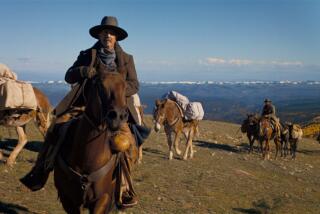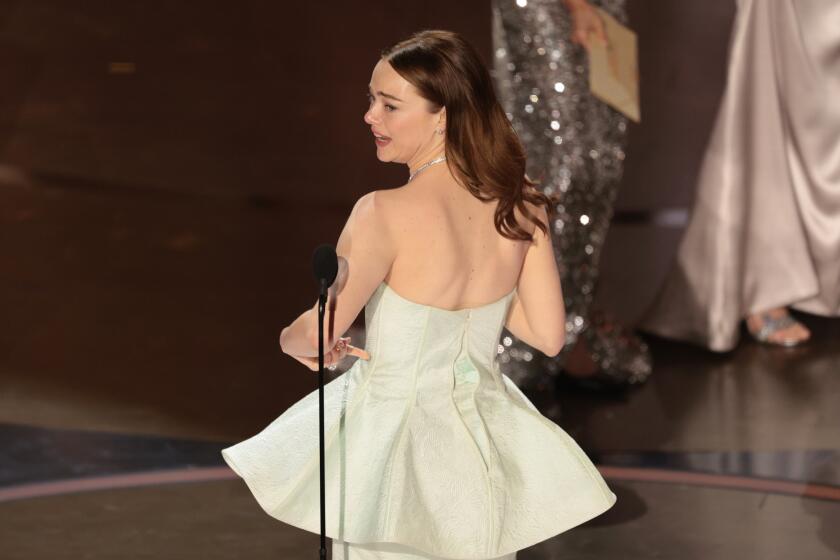Few Southern comforts
Nicole Kidman flopped down on a wooden bench on the porch of a replica Civil War-era Carolinas farmhouse. Surveying the gardens and pastures around her, she let out a long sigh. “This is tough,” she said, sounding tired. “It’s not exactly ‘Little House on the Prairie.’ ”
Yet “Little House on the Prairie” is what it looks like, albeit in the remote Transylvanian Alps. The views are idyllic and unspoiled; from her farmhouse porch on high, Kidman peered down a long, broad valley covered in dense forest starting to turn russet and gold on this sunny October day. In her 180-degree view, there was not a sign of modern life: no overhead power cables, no billboards, not even the distant hum of traffic.
That’s a major reason why she and the cast and crew of “Cold Mountain” have been in Romania since July. Charles Frazier’s 1997 debut novel, which won a National Book Award and became a bestselling publishing phenomenon, is set in rural 1860s North Carolina, and director-screenwriter Anthony Minghella’s adaptation for Miramax Films requires shooting in remote places untouched by progress.
“We started out going to the locations it was written in,” recalled producer Bill Horberg. “But the last 30 pages of the script call for snow, and you can’t rely on snow in the Carolinas. We’d always have had the need to move for snow. You can’t build sets in two places, so production logic dictated we move someplace where we get all the seasons.”
After locations in Canada, Australia, New Zealand, Poland and Ireland were considered and discarded, Romania became the choice. The film’s executive producer, Scotsman Iain Smith, had vacationed in the Transylvanian Alps, and he recommended the area to Minghella, who visited it last winter with production designer Dante Ferretti.
“There’s something so stark and primitive about this place that it struck us as suitable for a story set in 1864,” Horberg said. Indeed. On the 2 1/2-hour journey from Romania’s capital, Bucharest, one sees as many horses and carts on the roads as automobiles, while field laborers still wield scythes.
Something else about Romania proved to be suitable. It is a cheap place to shoot movies, ranging from the labor, the extras -- and 1,000 soldiers provided for battlefield scenes by the Romanian army. Horberg characterized the budget of “Cold Mountain” as “mid-70s,” saving what he estimated to be $20 million to $25 million had it been shot in the U.S.
“Cold Mountain” marks Minghella’s third consecutive literary adaptation, after Michael Ondaatje’s “The English Patient” and Patricia Highsmith’s “The Talented Mr. Ripley.”
“I agreed to write and direct the film of this book when I was only two-thirds through reading it,” he said. As an adaptor, Minghella makes radical changes to his source texts, rather than being enslaved by them. His approach this time is no exception. (Once Frazier sold the novel, he had no involvement in writing the screenplay.)
Novel versus screenplay
The hero of Frazier’s novel is Inman (played in the film by Jude Law), a Confederate soldier injured in battle. He begins the story in a convalescent hospital, but he abruptly decides to undertake the long, dangerous walk back to his hometown, Cold Mountain, to reunite with Ada (Kidman), with whom he had begun an unconsummated affair.
Meanwhile, Ada, who had a sheltered upbringing in Charleston ,S.C., society, is struggling to maintain the farm where she’d moved with her ailing father. After his death, she lacks the skills needed to survive. Only when Ruby (Renee Zellweger), a rugged young rural woman, moves in to share the farm does Ada begin her own journey toward self-sufficiency.
Frazier recounts all this in a rich, allusive style, describing the changing seasons and the often hostile weather encountered by Inman and Ada so closely that the climate almost functions as a dramatic character.
In contrast, Minghella’s screenplay begins by showing Inman’s part in the brutal, bloody battle of Petersburg, Va. “I decided this wasn’t going to be a Civil War film,” he said on a break between scenes. “I wanted to establish quickly the nature of a war and make the audience see why Inman would want to leave it and attend to his obligations at home.
“It made more sense to focus on Ada’s home and Inman’s journey home. In this story, Inman travels hundreds of miles -- a profound, life-changing journey. Ada begins in thrall to a culture that doesn’t serve her at all; she’s hoop-skirted, corseted and aristocratic. But she ends up running a farm with another woman and no men around.” Minghella has also departed from Frazier’s text by creating a more sharply focused danger to Ada and Ruby’s farm.
“There’s something perverse with me when it comes to material,” he said. “I react extremely to cold; I don’t like mountains; I knew nothing about the Civil War; and I have little interest in war generally. But the work I have to do to enable me to make a film like this -- the things I have to learn -- interests me as much as the story itself.”
As Kidman noted, if you embark on a film called “Cold Mountain,” it’s likely to be tough. The core crew is spending five months, from mid-July to mid-December, in this remote region.
The battlefield scenes, shot first in a village called Potigrafu, much closer to Bucharest, were particularly arduous. Temperatures rose to 105 degrees, and then came thunderstorms and wet weather so extreme that it caused flooding across Eastern Europe. Rain fell on 21 consecutive days early in the shoot.
“For the battle scenes, we had to dredge mud out of trenches before we could get in them,” Minghella said. “As a result, the footage has such an edge. You see soldiers sliding and slithering around helplessly. But we got covered in it. At one point, our Bucharest hotel wouldn’t let us back in until we changed out of our muddy clothes. Some days, I felt defeated by it all.”
“The battlefield scenes were hot, brutal and emotionally intense,” Law said. “One could choreograph certain set pieces, but once you put them among a mosh pit of 1,000 men sliding around in mud, it was hard to keep that choreography. And it was tough for a cameraman to be in the middle of all that chaos without becoming part of it.”
Other individuals paid their dues in terms of physical hardships. Kidman reluctantly showed a visitor her hands: scratched with dirty nails. Her forearms were covered in painful-looking welts and abrasions. “Oh, those,” she said, casually. “Well, yesterday, Renee and I had this fence-building scene, and I had to hammer this wooden post into the ground and get frustrated about it. So I attacked the post. I knew my hands were swollen, but I didn’t realize I’d done this. I don’t even notice when I’m harming my body.” She laughed mirthlessly. “But with this story, adversity helps. There’s something about smooth sailing that wouldn’t sit right.”
“Yep, that’s us -- fence-building, butt-kickin’ gals,” Zellweger said dryly, later in the day. Her nails were as dirty as Kidman’s, but she shrugs off the trials of filming “Cold Mountain”; she liked the book so much that she tried to option the film rights.
“Some friends from Charleston and I had an advance look at the book,” she said. “You hold something like that in your hands, and you recognize an epic immediately. It was glorious -- the colors, the characters, the details were so vivid. We had a smaller film in mind and tried to get the rights for $10,000.” (The film rights were finally sold for $1.25 million.) Zellweger laughed loudly and said: “What a tragedy it would have been if we had succeeded!”
The script’s Ruby is of mixed race. “Her heritage is never fully described,” Zellweger said. “But it seems there were people back then living in the hills who were a mix of white, Afro-American and maybe American Indian, with light eyes and light hair. Looking back on [the novel] more carefully, we’re just filling in the blanks.”
Casting gets complicated
During the casting process, Minghella talked with Zellweger, who had hoped to play Ada. “But when I met Renee, I thought she was born to play Ruby,” he said. “She told me she’d be happy to play whoever I wanted. And then it took me a year to get back to her.”
It took so long because the casting of the main characters was complex and prolonged. For a long time, Tom Cruise was set to play Inman, but he withdrew. “There were many, many changes of plan and permutations,” Minghella recalled. No one on set spelled it out, but after Cruise left, Kidman, who divorced the actor last year, became available to play Ada.
“The role wasn’t something I saw in my future,” Kidman said. “It fell before me by chance. But this story makes you ache. It evokes a sense of longing, which is hard to do. And I think I needed it. It’s lovely to be making a film about love at this time of my life. There’s a bleakness to the last three films I’ve done” -- the yet-to-be released “Dogville,” directed by Lars von Trier; the film of Philip Roth’s novel “The Human Stain”; and “The Hours,” in which she plays Virginia Woolf.
“I love the female friendship in this movie. And Ada, who at first is like a doll, not built to take care of herself, makes this huge progression.”
Still, the really intriguing casting is Englishman Law as the North Carolina hero Inman -- not just because of his accent, but because he has never before played the lead in a large-scale movie. “I was conscious of that,” said Minghella, who cast him in “The Talented Mr. Ripley.”
“Jude has so much of the equipment of a leading man, yet he seemed more secure creating a character. But when I talked to him about Inman, he said he was ready.” Law remembers something different from that same conversation: “Anthony made me feel that Inman was my part -- something I could do, and as he put it, something I deserved to do.”
Minghella insisted there was another reason he cast Law, Kidman and Zellweger: He knew all three actors would enter wholeheartedly into the spirit of the production, and do their work without complaints or tantrums for the duration of the marathon shoot.
“I have my crew, and they will go anywhere, do anything for me,” he said. “We couldn’t have a difficult, high-maintenance actor here, someone who needed more than Romania could offer.
“If you’re setting out on a tough journey and making a film like ‘Cold Mountain,’ you need to pick your companions very carefully.”
More to Read
Only good movies
Get the Indie Focus newsletter, Mark Olsen's weekly guide to the world of cinema.
You may occasionally receive promotional content from the Los Angeles Times.






